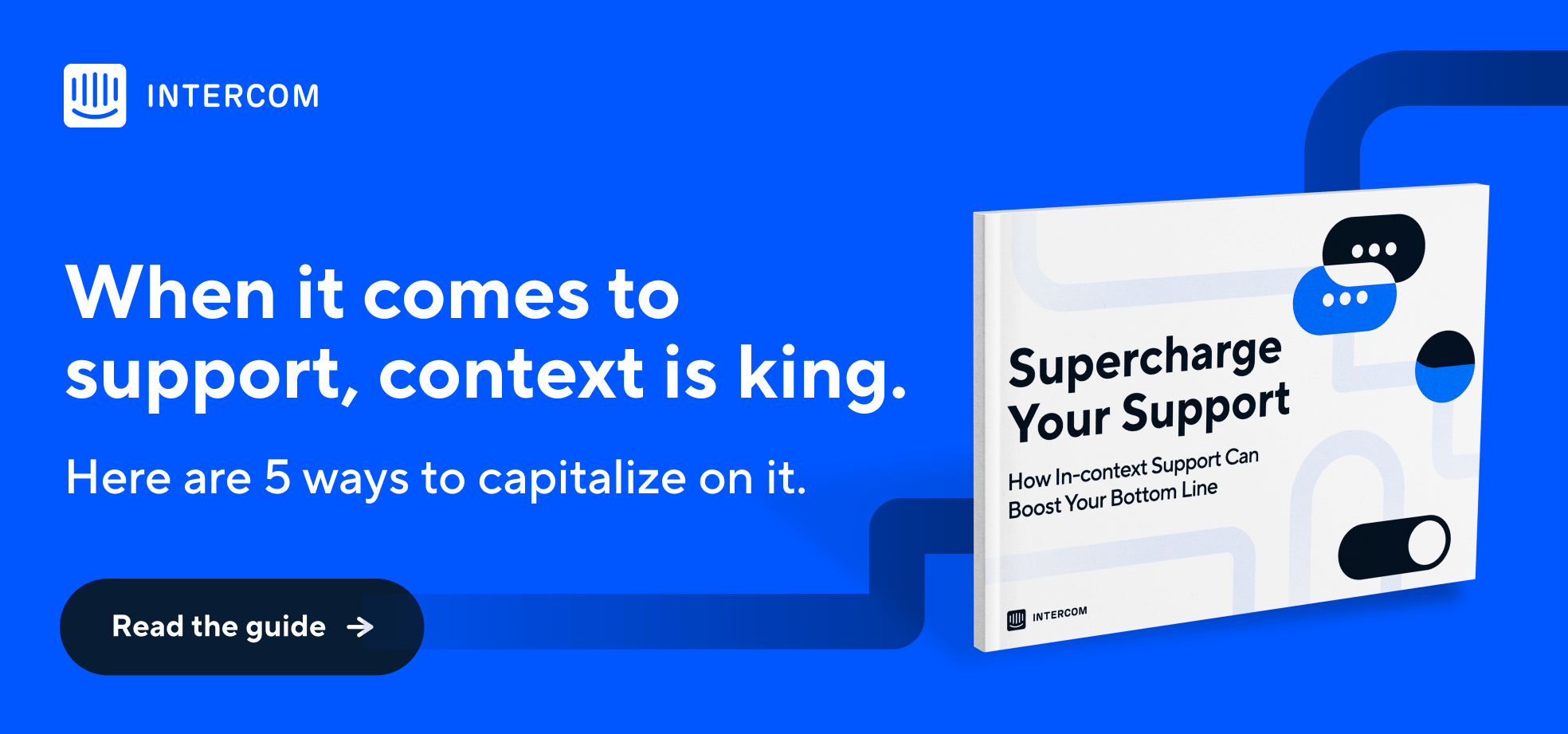
Ready to scale your customer service offering? Ask these 3 questions first
As your company grows, it’s easy to focus on shipping the next great feature or going after the shiniest logos.
But at these pivotal moments, it’s just as important to prioritize your customer service strategy as it is to plan your product roadmap or your next big marketing campaign.
After all, whether you’re aiming to drive product-led growth or you’re going with a sales-led strategy, once you’ve brought in those new users, you still need to provide an exceptional customer experience to keep them around long-term.
And as we know, it’s never been more important to deliver this exceptional service – or more challenging to get it right. We recently took a deeper dive into some of the major challenges facing support teams in this new world. But while all support teams have been feeling that crunch, there are also specific factors to consider depending on where your company is on its own journey.
“Make sure that your support team is set up for success from the outset”
Whether your business is preparing for a new phase of growth, or you’re experiencing an increase in customer service volume, you need to make sure that your support team is set up for success from the outset and that you’re creating the right customer service infrastructure to deliver exceptional customer experiences at scale.
With that in mind, here are three questions to ask when you want your customer service to grow to meet your customers’ needs – and some best practices to ensure it does.
1. Are your customer service tools scalable?
If you’ve been using outdated forms of customer service, like phone or even email, it’s time to reconsider. Phone support and email have a part to play in excellent customer service, but are notoriously difficult to scale: both require a significant labor investment without guaranteeing that high-quality customer experience.
Phone support is a one-to-one medium that requires a lot of waiting around to actually get the help you need. And when you’re finally connected with someone, it demands that both the customer and the support rep give it their full and exclusive attention in real time, which is often frustrating and wasteful for both parties. There’s also no easy way to track, search, and leverage the data from those conversations, so useful information gets lost as soon as the call ends.
Email can be a time-consuming, unproductive customer service channel too. Similar to phone support, your team can only respond to one customer at a time, and getting important qualifying information or routing queries to the right people can add hours (or even days!) to your resolution time.
“Trying to maintain too many legacy support channels will suck up all of your team’s time with very little return on investment”
These channels are perfectly suited to some queries, but for others, can be completely inefficient and inconvenient for customers. For proof, just look at the customer satisfaction ratings – one study found that only 61% of email users and 44% of phone users were satisfied with their support experience.
It’s clear that when it comes to customer service, you need the right tool for the job. But according to a commissioned study by Forrester Consulting on behalf of Intercom from April 2021, Drive Conversational Experiences for a Future-Ready Customer Support Strategy, only 43% of support leaders believe that they can deliver personalized support experiences with their current tech stack. And as you scale, trying to maintain too many of these legacy channels will suck up all of your team’s time with very little return on investment.
So if you’re trying to scale your customer service offering, it’s time to think deeply about which channels your customers actually want, and streamline your support tech stack to work for you.
The answer: A customer service solution that lets you own the conversation
This is where using a next-generation support tool really shines.
For starters, messenger-based conversational support is not only what customers want; it’s what they expect. According to Forrester’s research, messenger-based support has become the second most used support channel since the beginning of the pandemic. What’s more, they also found that 58% of support leaders and decision-makers believe that customers prefer conversational, messenger-based engagements with brands.
But messengers don’t just give the people what they want – they also make it so much easier for your team to maintain super-high support standards even as you scale.
With a next-generation support tool fuelling your customer support, you can:
- Improve efficiency by effortlessly collecting important information upfront that will help you to correctly route, triage, and resolve customer problems.
- Increase team productivity by enabling support reps to chat to multiple customers at once so they can resolve more queries, faster.
- Build long-lasting customer relationships by using historical context to send more personalized, targeted messages.
- Get deeper insights into your customers and their pain points.
- Use bots and automation to take care of simple queries so your team can focus on more complex, impactful problems.
- Deliver world-class support at scale by using a combination of proactive, self-serve, and human support capabilities to deliver efficient, timely, personal support experiences.
And as you’re choosing a support tool that can scale with you, remember to make sure it can integrate with the other tools you use daily for a more streamlined and efficient workflow.
2. How will you maintain your high standards as conversation volumes rise?
As you scale, it’s very likely that your conversation volumes are going to scale too. And it’s not just the number of queries that start to ramp up; as you introduce new customers, features, and use cases, the complexity of those queries starts to increase, too.
But whether you’re replying to 10 customers a day or 1,000, you still want each person to feel like one in a million. So how can you prepare for this increase in volume without sacrificing quality, efficiency, speed, or personalization?
It may seem like an impossible conundrum, but luckily you don’t need to add headcount just to keep up with an expanding inbox. Instead, think about how you can work smarter, not harder – and how you can leverage the resources you already have.
The answer: Use automation to deliver fast, personalized customer service at scale
One key way of doing this is by using automation to take care of simple, repetitive questions, so your team is free to focus on the more complex queries. Using customizable bots to resolve questions and offer up relevant help content, you can ensure personalized, high-quality, near-instant replies, 24/7 – even when your team is offline.
“Support teams who use chatbots are 60% more likely to report an improvement in resolution times and 30% more likely to report an increase in customer satisfaction”
In fact, our research shows that support teams who use chatbots are 60% more likely to report a definite improvement in resolution times, and 30% more likely to report a definite increase in customer satisfaction.
And while many support leaders initially fear that automation can make things less personal, the truth is that it actually empowers support teams of all sizes to deliver personalized, more customer-centric support.
Using automation where possible is a form of empathy: it shows that you understand your customer’s journey, you know what’s important to them, and you respect their time.
And when you know that a sensitive or difficult issue needs a human touch? Your support team will have more time and energy to dedicate to solving it.
3. Are you adapting to meet evolving customer needs?
Scaling isn’t always about just getting bigger; often, it can mean refining (or redefining) your audience, too. For many businesses, the process of scaling can also include moving upmarket to attract larger enterprise customers, many of whom will expect personalized, white-glove service as standard.
So as you start to expand your customer support strategy, you also need to reassess who your customers are and what they’re looking for. Which high-value, VIP customers need one-to-one human support, and how can you free up your team’s time to provide that without sacrificing the quality of the support experience that you provide to your smaller customers?
The answer: Understand your customers’ journey and get strategic with how you deliver support
When it comes to customer support, there’s no one-size-fits-all approach, and different customers will require different levels of support.
By incorporating self-serve and proactive layers into your support strategy, you can resolve more queries without needing to get a support rep involved at all – and with proactive support, you can answer questions your customers didn’t even know they had yet. This means that you can reduce the volume of conversations that reach your inbox in the first place, freeing up more time for your team to focus on delivering that all-important human support where it’s most needed.
“Laying the infrastructure for your self-serve and proactive support now can result in huge savings down the line”
Laying the infrastructure for your self-serve and proactive layers now can result in huge savings of time and money down the line, so it’s worth taking the time to get it right. The first step is to look at your customers’ journey with fresh eyes. Where are the pain points? Then, using data-driven insights from your support tool, look for gaps or emerging topics that customers are searching for.
With all of this rich context in mind, find ways to proactively address those known pain points: whether that’s writing a new help article that you can serve up at just the right moment, designing a product tour to help users activate a certain feature (so they don’t need to ask how later), or adding a targeted banner to let people know any relevant information upfront.
By creating resources that will help customers to self-serve 24/7, and proactively providing help before it’s needed, you can provide every customer with tailored, efficient support, while simultaneously freeing up more human resources for those high-impact VIP queries.
Scaling without sacrificing satisfaction
Customer support can be one of the most powerful tools in your arsenal when it comes to improving retention, reducing churn, and building your brand with loyal, satisfied customers. When done right, it can even become an engine for growth for your entire business, delivering value for every team. So as you start to plan for your next phase of growth, think strategically about how you can scale your customer support for long-term success, efficiency, and customer happiness.







